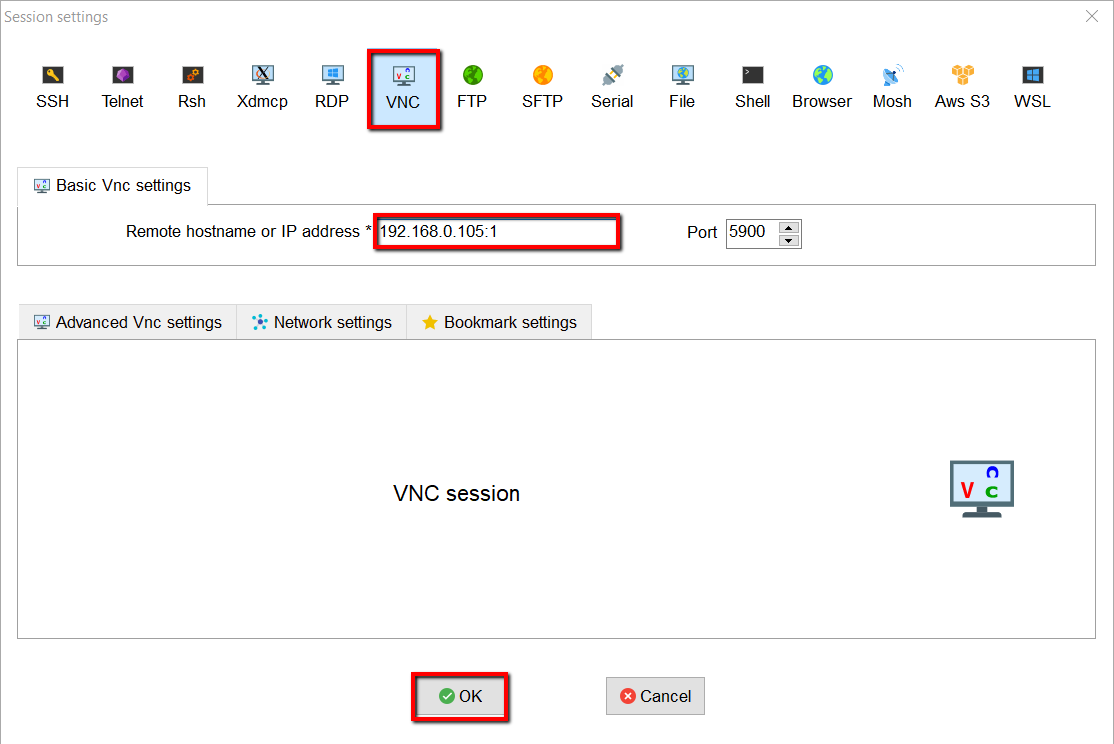

- INSTALL VNC CONNECT RASPBERRY PI HOW TO
- INSTALL VNC CONNECT RASPBERRY PI INSTALL
- INSTALL VNC CONNECT RASPBERRY PI SOFTWARE
- INSTALL VNC CONNECT RASPBERRY PI PASSWORD
INSTALL VNC CONNECT RASPBERRY PI SOFTWARE
While Vino implements the VNC protocol, it works by showing the current user’s desktop rather than creating the virtual desktop that TightVNC and other server software use. If you want to share your Raspberry Pi’s desktop, check out our guide on using Vino. One thing to note is that VNC creates a virtual desktop for the connection.
INSTALL VNC CONNECT RASPBERRY PI HOW TO
If you just want a barebones command-line approach, then be sure to check out the tutorial on how to SSH into your Raspberry Pi. It is both lightweight, free, and open-source that makes it perfect for the device. TightVNC is the software that will allow us to set our Pi up to accept VNC connections easily.
INSTALL VNC CONNECT RASPBERRY PI INSTALL
Setting up a VNC server on your Raspberry Pi is relatively straightforward and requires us to install and setup a single package called tightvncserver.

This removes the need to use SSH as the only way of accessing your Raspberry Pi. For example, you can use it to view your Pi’s desktop without having a monitor attached to it. Using VNC on your Raspberry Pi has a variety of uses. This protocol works differently to the Remote Desktop Protocol that Windows uses. You might also want to check out our article on how you can set up a headless Raspberry Pi with VNC Connect.VNC is a special protocol that is designed to allow one device to control another remotely. You can also find out more detailed information regarding this on our help page. To sum it up, remote controlling a Raspberry Pi is just as easy as it is on any other device. Stopping the remote virtual desktop is also easy. Next, enter it into VNC Viewer and you will be able to connect. To this, run the command vncserver on your Raspberry Pi and write down the IP address and display number. This is very handy if your Raspberry Pi is not connected to a monitor. You can even create and remote into a virtual desktop.

Then, search for that machine and connect as usual. If you wait to connect from a Raspberry Pi to another machine, you only need to open VNC Viewer. You can do other tasks, such as printing or transferring a file, as you normally would in Viewer. The default one is raspberry, but it’s a great idea to change it as quickly as possible.
INSTALL VNC CONNECT RASPBERRY PI PASSWORD
By default, the account is pi and the password is whatever you have set it to. When asked for login credentials, you need to use your Raspberry Pi’s ones. Note that this does not need a logged-in RealVNC account. Of course, you can also make note of the IP address shown in VNC Server, initiating a Direct Connection. On your device running VNC Viewer (and using the same account), your Raspberry Pi should show. This is no different from the way you would connect to any other machine running VNC Server. Even with a Home license, you will have access to both Cloud and Direct Connections. Make sure you log in with your RealVNC account. Once you’ve done that, the software will start every time you boot. Then, in the graphical desktop, go to Menu > Preferences > Raspberry Pi Configuration > Interfaces. This will make sure you’re running the latest version.

Open a terminal window and run the command sudo apt-get update, then sudo apt-get install realvnc-vnc-server. If not, you can always install the VNC software later.Īlso, you will need to enable VNC software on your device before being able to use it. The only prerequisite is that your Pi has Raspberry Pi OS installed. Īs mentioned, Raspberry Pi comes with VNC Server and VNC Viewer installed. There are also other great ways to make the most out of VNC Connect, as you can find out here. Read on to find out how to set up Raspberry Pi for use with VNC Connect.


 0 kommentar(er)
0 kommentar(er)
